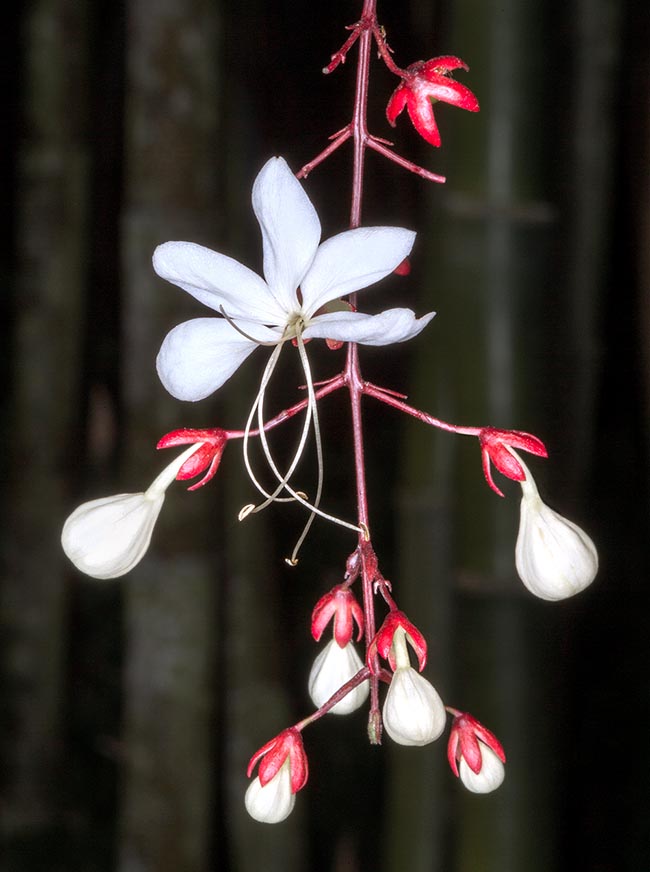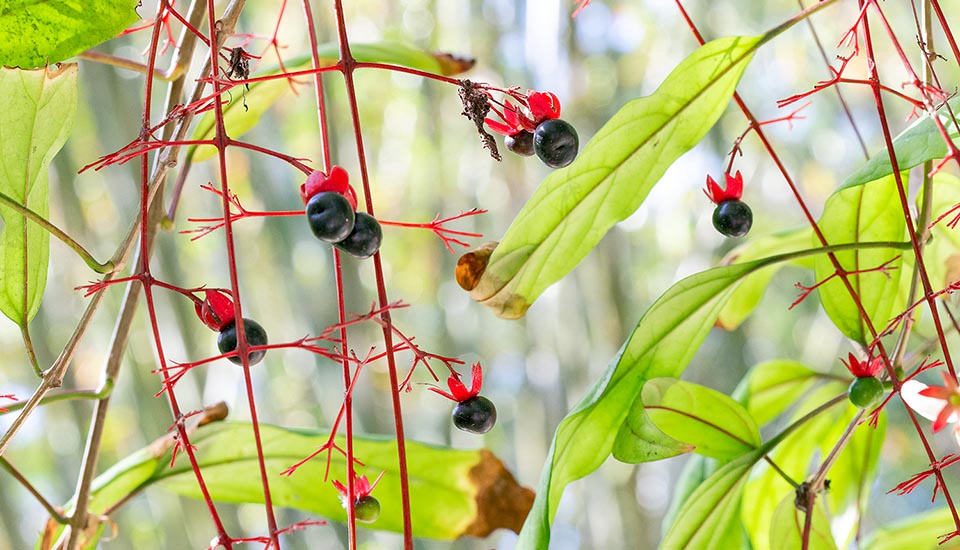Family : Lamiaceae

Text © Pietro Puccio

English translation by Mario Beltramini

The flowers of the Clerodendron schmidtii look like lamps, hence the bizarre English name of “light-bulbs” © Giuseppe Mazza
The species is native to Cambodia, Laos and Thailand where it grows in the forests of Dipterocarpaceae, evergreen as well as deciduous, from the sea level up to about 500 m of altitude.
The name of the genus is the combination of the Greek terms “κλῆρος” (cleros) = fate and “δένδρον” (dendron) = tree, name given by Johannes Burman (1707-1780), resumed by Linnaeus, to a plant that in Ceylonese was called “pinnacola” = unlucky; the species is honoured to the Danish naturalist Ernst Johnnes Schmidt (1877-1933) who collected some samples of it in the Thailand island of Ko Chang.
Common names: chains of glory, lightbulbs (English); taai bai, thao yaai mom paa, put raa chaa (Thai).
The Clerodendrum schmidtii C. B. Clarke (1905) is a shrub or a small evergreen tree, up to about 3 m tall, very ramified with cylindrical branches tendentially drooping, pubescent.
The leaves, on a 5-8 cm long petiole covered by short and dense hair, are opposite, simple, oblong with acuminate apex, cordate to auriculate base and slightly waved entire margin, rough to the touch, 12-18 cm long and 5-8 cm broad, of intense green colour.
Inflorescences, on an about 5 cm long peduncle, panicle-like terminal, of dark red colour, pubescent, hanging, 20-45 cm long, with numerous flowers with calyx, 0,6 cm long, having 5 lanceolate, deeply incised, lobes, persistent in fruit, of intense red colour.
Hypocrateriform corolla (with stretched lobes perpendicular to a long thin tube) of white colour, corolline tube, 1 cm long, with 5 obovate lobes, about 1,5 cm long, and 4 prominent stamens. The fruits are globose drupes, of about 1 cm of diameter, black when ripe.
It propagates by seed, previously scarified and kept in water for one day, in draining loam maintained constantly humid, but without stagnations, at the temperature of 24-26 °C, and by semi-woody cutting in spring-summer.
One of the most characteristic Clerodendrum due to its long inflorescences hanging from the luminous white flowers, that when in bud look like tiny light bulbs, hence one of the common names, cultivable in tropical and humid subtropical climate regions, its cultivation may be tried in the mildest temperate-warm ones where temperatures close to 0 °C are short lasting exceptions.

This 3 m evergreen shrub or small tree, native to Cambodia, Laos and Thailand, has globose fruits, black when ripe, of about 1 cm © Giuseppe Mazza
It requires full sun or a slight shade and draining, fertile soils, regularly irrigated during the dry periods. In the less favourable climates it is to be cultivated in pot, even of suspended, in loam rich of organic substance with addition of 30 % of coarse siliceous sand or agricultural perlite to improve the drainage, at the maximum possible luminosity and with lowest winter temperatures not under 14 °C. The watering must be regular and abundant during the growth, but avoiding stagnations, being very sensitive to rottenness, spaced in winter, without ever getting the substratum completely dry.
Synonyms: Clerodendrum hastato-oblongum C.B.Clarke (1905); Clerodendrum schmidtii var. macrophyllum Moldenke (1972); Clerodendrum schmidtii var. glanduliferum Moldenke (1979).
→ To appreciate the biodiversity within the family LAMIACEAE please click here.
